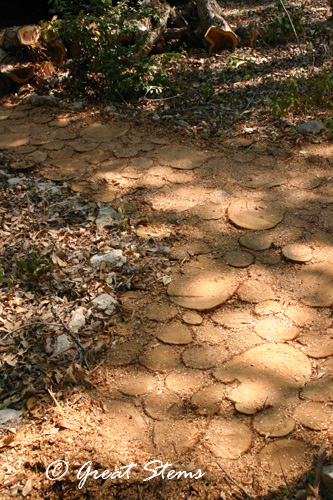
Meet the wood path that cost us nothing but time and the purchase
of a $50 electric chainsaw.
Our side yard has long been a wild mix of large trees, understory trees and shrubs, brambles, and a set of plants I’ll just refer to as “miscellaneous.” I consider it woodland despite the fact that it sits between two houses, and in fact it serves as a small habitat corridor that is very popular with the wildlife. I’m quite fond of this area, and I intend to fill it in with many more wildlife-friendly native plants to serve as a habitat, visual screen, and sound barrier (we live near a highway).
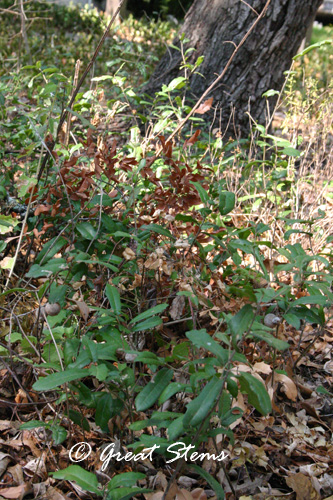
We’ve attempted planting a bit here and there. However, the Oak sprouts mixed with the prickly vines of Dewberry and Greenbrier have been, if you’ll pardon the pun, a thorn in my side. I don’t actually want to get rid of them, but I do want to control them so that I can increase other plant diversity. It was clear that I needed a better plan of attack so that I could successfully manage the area. A pathway was in order. But I wanted it to be natural, cheap, and nature-friendly.
I thought about just using cedar mulch. But I wanted something that would be clearly defined and easy to maintain — mulch can spread beyond its original boundaries and will sometimes still let weeds through. Decomposed granite has its own issues. But thanks to a few cedar logs I had around from a previous project, I became inspired to slice them up to create mock flagstones. Of course, I needed a lot more logs, so I looked for free wood of various diameters on Craigslist. I think we used about three mini-van loads worth for this project (I’m so technical).
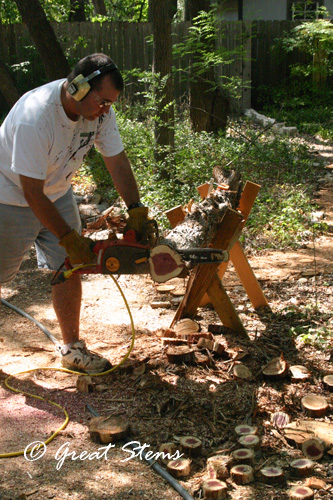
We realized pretty quick that it takes time to slice up a lot of logs. To make it easier, my husband built a little stand to hold the logs — what a difference that made. While he cut the logs into roughly 1.25″ slices, the rest of us cleared brambles and miscellaneous plants to create a pathway through the trees.
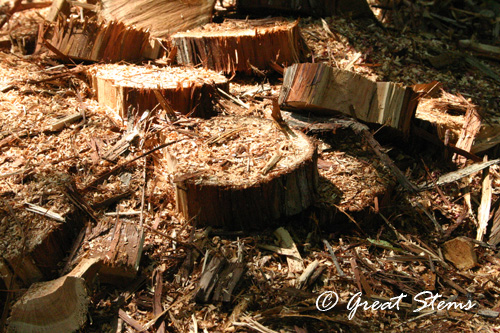
I had fun laying the path — it was like working on a giant jigsaw puzzle. Of course, it was pretty easy to fit the pieces together on this one. You can see the red color of the freshly cut logs mixed with older slices that had already turned brown.
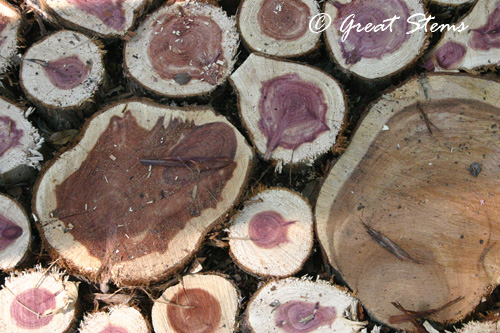
And rather than lay them in sand, which I never like mixing with clay soil if I can help it, I just laid them directly on the dirt.
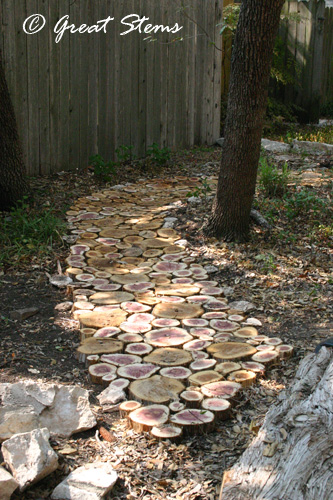 The log slices follow the natural ups and downs of the soil — I made no attempt to level the ground anywhere.
The log slices follow the natural ups and downs of the soil — I made no attempt to level the ground anywhere.
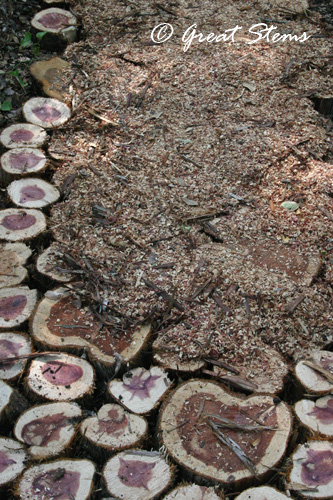 After laying the path, I spread leftover sawdust to fill the gaps between the slices, like mortar — except not like mortar.
After laying the path, I spread leftover sawdust to fill the gaps between the slices, like mortar — except not like mortar.
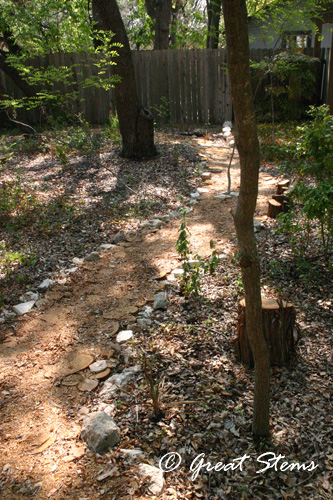
A view of a longer portion of the path, still covered in a cushion of sawdust
I also added a few small limestone rocks gathered from around the yard to give a casual border to the path. The path defines the future planting areas for the tree-covered area. I envision an assortment of understory trees, shrubs, and perennials adding pleasant greenery to the already scenic wood path.
To show off the cedar, I swept the wood path with a broom. The sawdust between the slices created a finished look. Here’s where I’ll admit that I actually like the path still fully covered in sawdust equally as well — the sawdust gives an extra cushion that lets you bounce a little along the path. But then you miss getting to see the log slices underneath, and they are just plain cool.
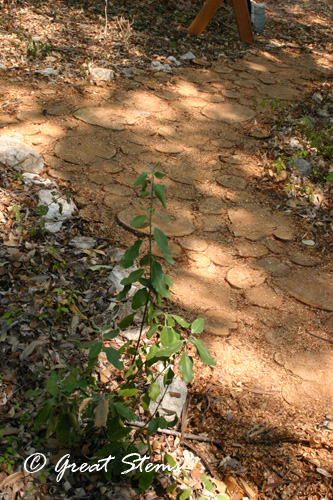
Cedar log slices with saw dust used to fill the gaps
I am obsessed with our new path. Everytime I look at it, I just sigh a peaceful sigh. Of course, it’s still too hot and dry to plant anything around the path right now, but the path is so pleasant in appearance that while inside I repeatedly walk over to the kitchen window to see it again.
The advantages to this wood path are many, as I have discovered:
- It’s natural and organic
- It’s free (except the electric chainsaw, a small one that we spent $50 on)
- The wood is locally obtained and grows readily in Central Texas
- The space between the slices easily lets moisture penetrate the soil below
- Ashe Juniper is naturally rot resistant
- It’s comfortable to walk on
- You can walk barefoot on it, too
- Log slices can be easily moved around or replaced, not that we’ve had to
- The path stays in place without shifting
- The path can be swept with a broom or raked
- It’s easy to create
- I can use leftover wood bits in my closet to keep moths out. And the cedar smells great.
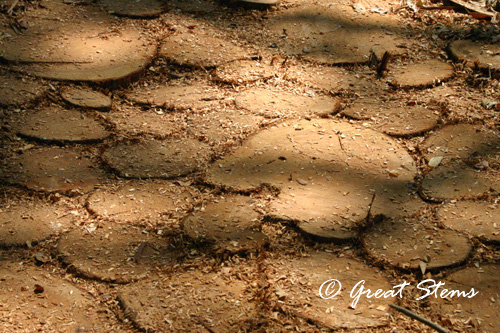 The logs are staying nicely in place, human- and wildlife-tested. Were this path in our backyard, I’m certain that our big, rambunctious dogs might test it to its limits, though.
The logs are staying nicely in place, human- and wildlife-tested. Were this path in our backyard, I’m certain that our big, rambunctious dogs might test it to its limits, though.
Is this a weekend project? Yes. Did it take us months because we are lazy slowpokes? Yes. But do we love it? YES!
Wonderful idea. Love the organic, zen quality about it.
Ok I love your posts- you always have the coolest ideas. This one is very very cool. Love it. The finished path looks beautiful- love the side accents.
What a neat idea and it looks so great. Also love your log planters. Hope you have a great week.
I really, really like this idea. I wonder how they hold up under a lot of rain(if we ever get any).
Thanks, all! Ann, it rained once when we first started the path (seems like so long ago) and the path had absolutely no change at all, other than to get damp, so clearly the cedar logs and rain are very compatible! In fact, the weather should just go ahead and let it rain right now to prove it…
What a great idea! We have one or two (or a thousand) cedar trees around here, and I think I’m getting a baby chainsaw for my birthday next week!
Very cool. Very resourceful!
That’s a fantastic look! I’d love to hear how it’s holding up after a few months, a year, etc.
The real question is: are you now eager to watch the lumberjack competitions on ESPN? I’m guessing “yes”.
That path is just fantastic. No wonder you’re happy.
It’s like replacing our windows. We started THAT in 2006 and we finished with the windows in 2010. We still have to replace the sliding glass door.
Also, could you send me a list of good wildlife native plants for my shady corner, PLEASE!!! Not that I’ll be planting anything back there in this heat, but still, it’s nice to start planning. 🙂 I remember pigeon berry, beauty berry, and buckeye. But I thought there were a few others I was supposed to try to get…
Katina, I sent you an e-mail just now with a lot of plant options. Let me know if you have questions about any of the plants. Good luck!
What a creative and appropriate path for a woodland, Meredith. It looks great!
Definitely a zen moment just looking at it. I can only imagine how awesome it is to walk on! That’s a great idea for all the reasons you listed. Kudos!
leaves an – I’m forever blowing bubbles – feeling of happiness.
It’s so beautiful. I can see why you can’t stop regarding your path and are obsessed.
What a wonderful, natural idea! You are so creative. I have a small woodland type of path where I’ve been using cedar mulch. What type of chainsaw did you get, if you don’t mind saying? I’ve been looking at lighweight, inexpensive, electric chainsaws in the $49.99 price range for the past few months. Looking for one where the chain is easy to install and doesn’t slip easily since I will be using and am inexperienced!
Thanks, everyone! I was out there this morning making sure one of my young plants got some water and I caught myself thinking about the bounce in my step and I realized I was walking on the cushiony path — it was springing me along. Fun!
Carol, we got the 14″ Homelite chainsaw from Home Depot. As the reviews said, the chain did slip on occasion, but nothing too bad. My husband figured out the proper tightness and it minimized the problems.
Great idea, i might do this as a path from my deck to a concrete tile patio at the other end of our yard, although I’m worried about 2 things; my 85 lb labrador, whether she eats the cedar tiles or just inadvertently throws them around when she’s running. I’m also sketchy with the spring thaw, considering its not in a wooded area, and I was hoping grass could grow in between rather than using sawdust. The only thing I could think of to avoid the tiles moving around was to make them 4″ and dig them into the soil a bit more.
Thanks for the pictures, I’m glad someone succeeded in completing this project.
That really came out well didn’t it? Your pictures are great but it just doesn’t do it justice. I’ve seen it in person and I know how good it looks. I was so impessed. I like it.
Thanks Meredith! That is one of the lightweight chainsaws I have looked at.
Great project Meredith.
Do you think ground thyme would be compatible in between the cedar disks?
I am in the process of doing the same thing for our patio but a coworker told me that when she did the same project it only lasted a year and then the wood rotted out and it had to be dug up. How has your path been holding up? Of course we live in Vancouver, BC, Canada and I’m sure the fact that its wet here 11 months of the year will play into how long it will last.
Great job on the pathway! I hope ours is as successful and will last.
Ty, sorry for the delay in responding. Our path continues to hold up well, even in rain. We periodically need to pull an oak sprout or two that might grow up between the cedar disks. But if you have water there 11 months of the year, I’m not sure you’ll have the same experience we’ve had. In any case, I can tell you we still very much love our path!
I suppose so, but you wouldn’t be able to keep the cedar disks tightly packed for walking, and by themselves they are a tripping hazard. I think stone is perhaps a better option for thyme.
Looks great. Can you walk on it barefoot comfortably? I tend to walk barefoot alot… I like the idea and I have a ton of cedar I am felling.
I walk comfortably barefoot on mine, but you’ll need to make sure to saw the cedar slices without overly rough or jagged edges. There is always the risk of splinters, but so far I’ve had none. Most of the time I’m in shoes, though. Good luck!
Pingback: Homemade Cedar Trellises | Great Stems
Just found your post on pinterest and it’s exactly what I want to do with an area in my backyard here in southern Ontario. Thank you for the simple instructions and lack of preparation for laying the cedar slices. I know this post is at least 3 years old but hopefully you are still enjoying your woodland garden path!
We sure are, Alex. The path is just now starting show a little aging, but it is still intact and a wonderful walkway. We do have to weed it a little in the spring, though. A few make their way through between the slices.